Tamilnadu State Board New Syllabus Samacheer Kalvi 12th Accountancy Guide Pdf Chapter 3 Accounts of Partnership Firms-Fundamentals Text Book Back Questions and Answers, Notes.
Tamilnadu Samacheer Kalvi 12th Accountancy Solutions Chapter 3 Accounts of Partnership Firms-Fundamentals
12th Accountancy Guide Accounts of Partnership Firms-Fundamentals Text Book Back Questions and Answers
I Multiple Choice Questions
Question 1.
In the absence of partnership deed, profits of the firm will be shared by the partners in
(a) Equal ratio
(b) Capital ration
(c) Both (a) and (b)
(d) None of these
Answer:
(a) Equal ratio
![]()
Question 2.
In the absence of an agreement among the partners, interest on capital is
(a) Not allowed
(b) Allowed at bank rate
(c) Allowed @ 5% per annum
(d) Allowed @ 6% per annum
Answer:
(a) Not allowed
Question 3.
As per the Indian Partnership Act, 1932, the rate of interest allowed on loans advanced by partners is
(a) 8% per annum
(b) 12% per annum
(c) 5% per annum
(d) 6% per annum
Answer:
(d) 6% per annum
Question 4.
Which of the following is shown in profit and loss appropriation account?
(a) Office Expenses
(b) Salary of staff
(c) Partner’s salary
(d) Interest on bank loan
Answer:
(c) Partner’s salary
![]()
Question 5.
When fixed capital method is adapted by a partnership firm, which of the following items will appear in capital account?
(a) Additional capital introduced
(b) Interest on capital
(c) Interest on drawings
(d) Share of profit
Answer:
(a) Additional capital introduced
Question 6.
When a partner withdraws regularly a fixed sum of money at the middle of every month period for which interest is to be calculated on the drawings on an average is
(a) 5.5 moths
(b) 6 months
(c) 12 months
(d) 6.5 months
Answer:
(b) 6 months
![]()
Question 7.
Which of the following is the incorrect pair?
| (a) Interest on drawings | Debited to capital account |
| (b) Interest on capital | Credited to capital account |
| (c) Interest on loan | Debited to capital account |
| (d) Share of profit | Credited to capital Account |
Answer:
c
Question 8.
In the absence of an agreement, partners are entitled to
(a) Salary
(b) Commission
(c) Interest on loan
(d) Interest on capital
Answer:
(c) Interest on loan
Question 9.
Pick the odd one out
(a) Partners share profits and losses equally
(b) Interest on partners capital is allowed at 7% per annum
(c) No salary or remuneration allowed
(d) Interest on loan from partners is allowed at 6% per annum
Answer:
(b) Interest on partners capital is allowed at 7% per annum
![]()
Question 10.
Profit after interest on drawings, interest on capital and remuneration is ₹ 10,500. Geetha, a partner, is entitled to receive commission @ 5% on profits after charging such commission. Find out commission.
(a) ₹ 50
(b) ₹ 150
(c) ₹ 550
(d) ₹ 500
Hint:

Answer:
(d) ₹ 500
II Very Short Answer Questions
Question 1.
Define partnership.
Answer:
According to Section 4 of the Indian Partnership Act, 1932, the partnership is defined as, “the relation between person who has agreed to share the profits of a business carried on by all or any of them acting for all.
Question 2.
What is a partnership deed?
Answer:
A partnership deed is a document in writing that contains the terms of the agreement among the partners.
Question 3.
What is meant by the fixed capital method?
Answer:
Under the fixed capital method, the capital of the partners is not altered and it remains generally fixed. Two accounts are maintained for each partner namely:
- Capital account and
- Current account
The transactions relating to initial capital introduced, additional capital introduced, and capital permanently withdrawn are entered in the capital account and all other transactions are recorded in the current account.
Question 4.
What is the journal entry to be passed for providing interest on capital to a partner? For providing interest on capital.


![]()
Question 5.
Why profit and loss appropriation account prepared?
Answer:
The profit and loss appropriation account is an extension of the profit and loss account prepared for the purpose of adjusting the transactions relating to amounts due to and amounts due from partners. It is a nominal account in nature. The balance being the profit or loss is transferred to the partners’ capital or current account in the profit-sharing ratio.
III Short Answer Questions
Question 1.
State the features of partnership?
Answer:
Following are the essential features of a partnership.
- A partnership is an association of two or more persons. The maximum number of partners is limited to 50.
- There should be an agreement among the persons to share the profit or loss of the business. The agreement may be oral or written or implied.
- The agreement must be to carry on a business and to share the profits of the business.
- The business may be carried on by all the partners or any of them acting for all.
Question 2.
State any six contents of a partnership deed.
Answer:
Contents of partnership deed.
Generally, a partnership deed contains the following:
- Name of the firm and nature and place of business.
- Date of commencement and duration of business.
- Names and addresses of all partners.
- Capital contributed by each partner.
- profit sharing ratio
![]()
Question 3.
State the differences between fixed capital method and fluctuating capital method.
Differences between fixed capital method and fluctuating capital method.
Answer:
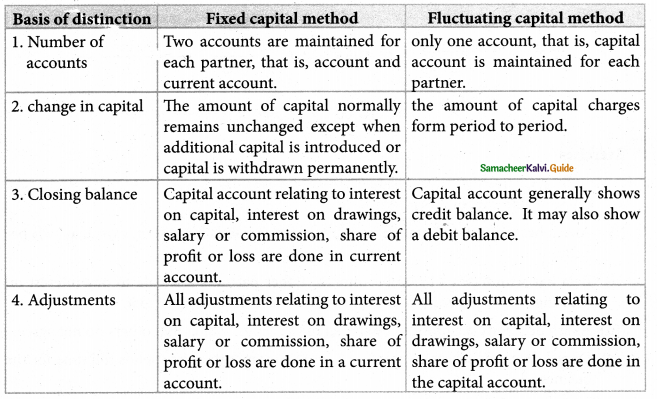
Question 4.
Write a brief note on the applications of the provisions of the Indian Partnership Act, 1932 in the absence of a partnership deed.
Answer:
Applications of the provisions of the Indian Partnership Act, 1932 in the absence of partnership deed.
- Remuneration to partners: No salary or remuneration is allowed to any partner. [Section 13(a)]
- Profit-sharing ratio: Profit and losses are to be shared by the partners equally. [Section 13(b)]
- Interest on capital: No interest is allowed on the capital. When a partner is entitled to interest on capital contributed as per partnership deed, such interest on capital will be payable only out of profits [Section 13(c)]
- Interest on loans advanced by partners to the firm: Interest on the loan is to be allowed at the rate of 6 percent per annum. [Section 13(d)]
- Interest on drawings: No interest is charged on the drawings of the partners.
Question 5.
Jayaraman is a partner who withdrew 10,000 regularly in the middle of every month. Interest is charged on the drawings at 6% per annum. Calculate interest on drawings for the year ended 31st December 2018.
Answer:

![]()
IV Exercises
Question 1.
Akash, Bala, Chandru, and Daniel are partners in a firm. There is no partnership deed. How will you deal with the following?
- Akash has contributed to maximum capital. He demands interest on capital at 10% per annum.
- Bala has withdrawn ₹ 3,000 per month. Other partners ask Bala to pay interest on drawings @ 8% per annum to the firm. But, Bala did not agree to it.
- Akash demands the profit to be shared in the capital ratio. But, others do not agree.
- Daniel demands a salary at the rate of ₹ 10,000 per month as he spends full time for the business.
- The loan advanced by Chandru to the firm is ₹ 50,000. He demands interest on loan@ 12% per annum
Solution:
- No interest on capital is payable to any partner.
- No interest is chargeable on drawings made by the partner.
- Profits should be distributed equally
- No remuneration is payable to any partner.
- Interest on the loan is payable at 6% per annum.
Question 2.
From the following information, prepare capital accounts of partners Rooban and Deri, when their capitals are fixed.
Answer:
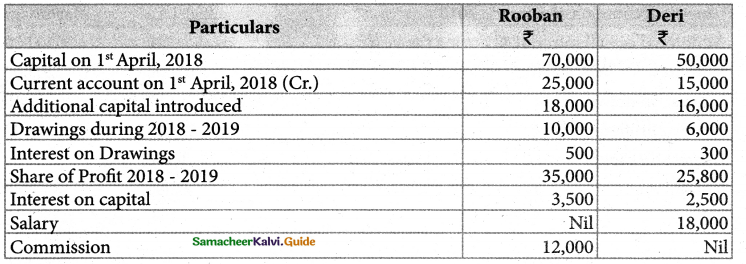
Solution :
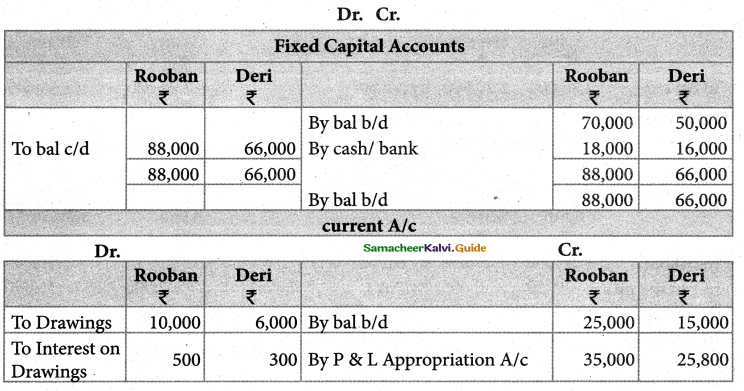

Question 3.
Arun and Selvam are partners who maintain their capital accounts under fixed capital method. From the following particulars, prepare capital accounts of partners.
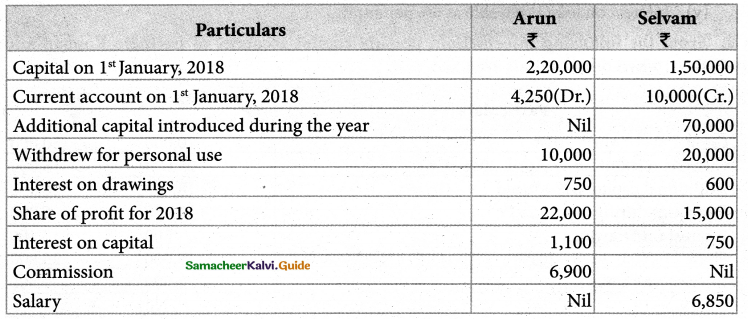
Solution :
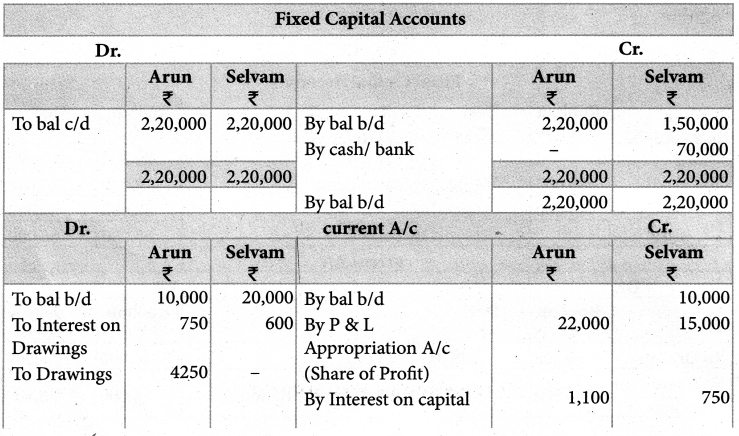

Question 4.
From the following information, prepare capital accounts of partners Padmini and Padma, When their capitals are fluctuating.
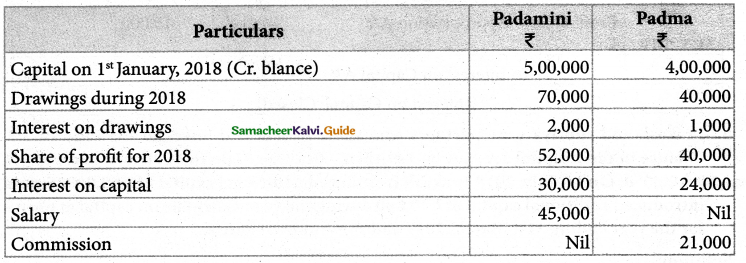
Solution :
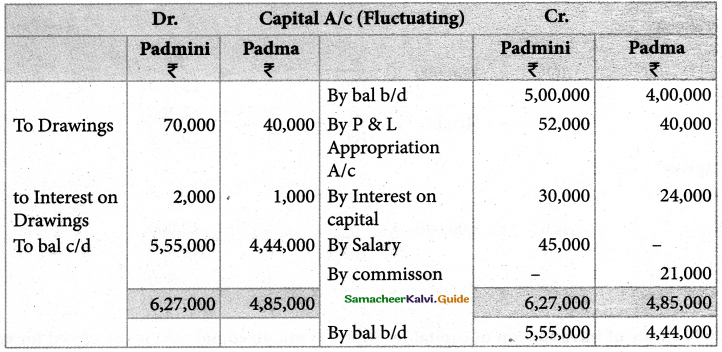
![]()
Question 5.
Mannan and Ramesh share profits and losses in the ratio of 3:2 and their capital on 1st April 2018 were Mannan ₹ 1,50,000 and Ramesh ₹ 1,00,000 respectively and their current accounts show a credit balance of ₹ 25,000 and ₹ 20,000 respectively. Calculate interest on capital at 6% p.a for the year ending 31st March 2019 and show the journal entries.
Solution :
For providing interest on capital
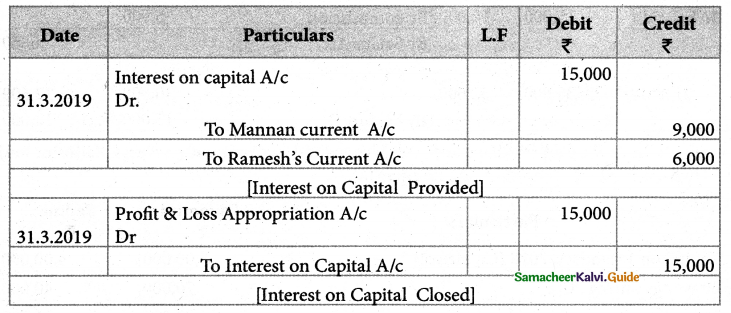
Question 6.
Prakash and Supriya were partners who share profits and losses in the ratio of 5:3. Balance in their capital account on 1st April 2018 was Prakash ₹ 3,00,000 and Supriya ₹ 2,00,000. On 1st July 2018 Prakash introduced additional capital of ₹ 60,000. Supria introduced additional capital of ₹ 30,000 during the year. Calculate on capital at 6% p.a for the year ending 31st March 2019 and show journal entries.
Solution:
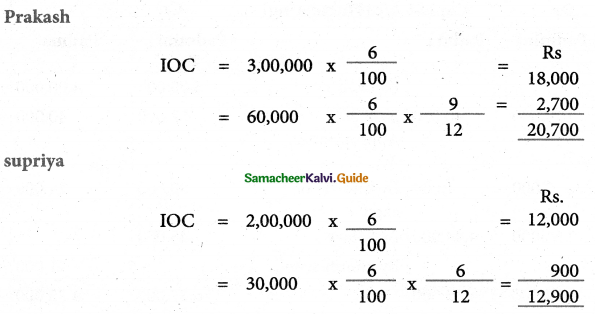
Note: Date of introduction of capital by Supria is not given, interest is calculated for an average period of 6 months.


Question 7.
The capital account of Begum and Fatima on 1st January 2018 showed a balance of ₹ 50,000 and ₹ 40,000 respectively. On 1st October 2018, Begum introduced an additional capital of ₹ 10,000 and On 1st May 2018 Fatima introduced an additional capital of ₹ 9,000. Calculate Interest on capital at 4% p.a. for the year ending 31st December 2018.
Solution :
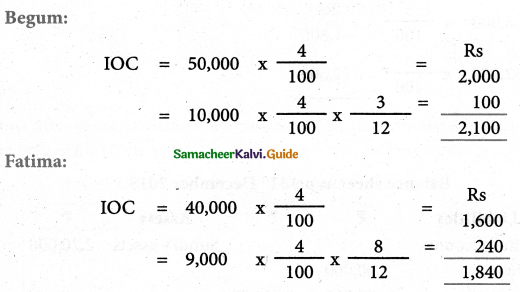
Interest on capital
Begum Rs. 2,100
Fatima Rs. 1,840
![]()
Question 8.
From the following balance sheets of Subha and Sudha who share profits and losses in 2:3, Calculate interest on capital at 5% p.a. for the year ending 31st December 2018.
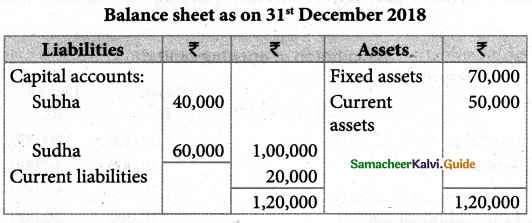
Drawings of subha and sudha during the year were ₹ 8,000 and ₹ 10,000 respectively. Profit earned during the year was ₹ 30,000.
Solution :
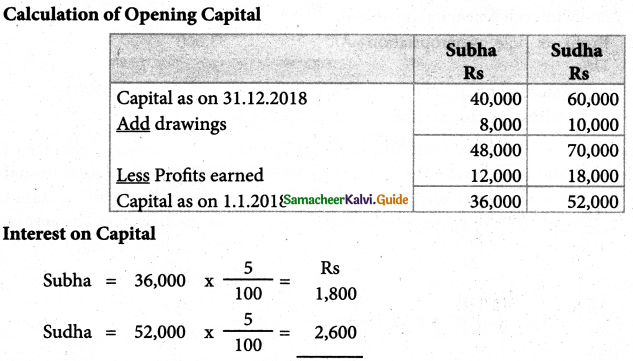
Question 9.
From the following balance sheets of Rajan and Devan who share profits and losses in 2:1, Calculate interest on capital at 6% p.a. for the year ending 31st December 2018.
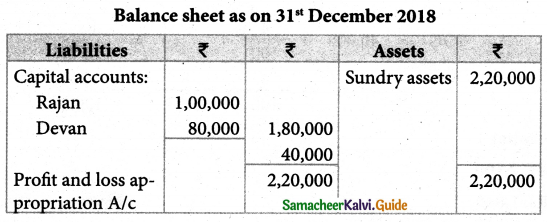
on 1st April, Rajan introduced an additional capital of ₹ 40,000, and on 1st September 2018. Devan introduced ₹ 30,000. Drawings of Rajan and Devan during the year were ₹ 20,000 and ₹ 10,000 respectively. Profit earned during the year was ₹ 70,000
Solution :
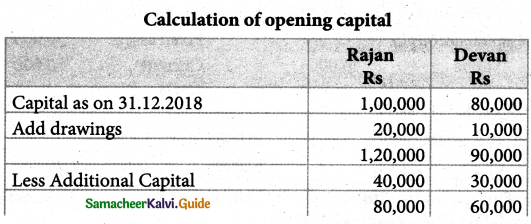

Interest on Capital
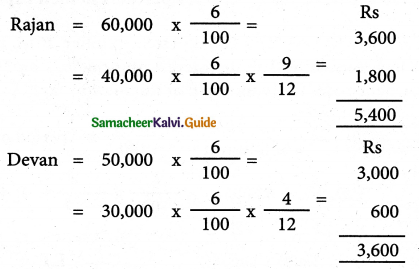
Interest on capital
Rajan = Rs. 5,400
Devan = Rs. 3,600
Question 10.
Ahmad and Basheer Contribute ₹ 60,000 and ₹ 40,000 respectively as capital. Their respective share of profit is 2:1 and the profit before interest on capital for the year is ₹ 5,000. Computer the amount of interest on capital in each of the following situations:
- If the partnership deed is silent as to the interest of capital
- If interest on capital @ 4% is allowed as per the partnership deed
- If the partnership deed allows interest on capital @ 6% per annum.
Solution
interest on capital @ 4%
Ahamed = 60,000 × \(\frac{4}{100}\) = 2,400
Basheer = 40,000 × \(\frac{4}{100}\) = 1,600
interest on capital @ 6%
Ahamed = 60,000 × \(\frac{6}{100}\) = 3,600
Basheer = 40,000 × \(\frac{6}{100}\) = 2,400
- No Interest on capital is allowed
- Since there is sufficient profit, interest on capital wifi be provided Ahamad. ₹ 2,400; Basheer. ₹ 1,600
- Since the profit is insufficient, interest on capital will not be provided. profit of ₹ 5,000 will be distributed to the partners in their capital ratio of 3:2
![]()
Question 11.
Mani is a partner, who withdrew ₹ 30,000 on 1st September 2018. Interest on drawings is charged at 6% per annum. Calculate interest on drawings on 31st December 2018 and show the journal entries by assuming that the fluctuating capital method is followed.
Solution :
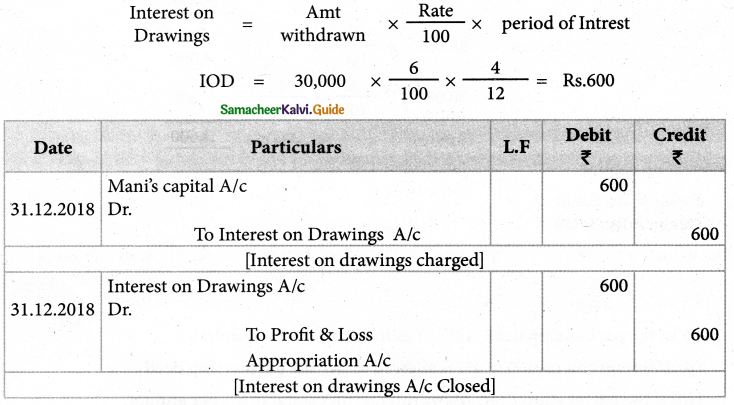
Question 12.
Santhosh is a partner in a partnership firm. As per the partnership deed, interest on drawings is charged per annum. During the year ended 31st December 2018 he withdrew as follows:
| Date |
Rs |
| February | 1 2,000 |
| May 1 | 10,000 |
| July 1 | 4,000 |
| October 1 | 6,000 |
calculate the amount of interest on drawings.
Solution :

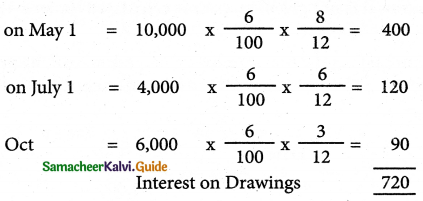
Question 13.
Kumar is a partner in a partnership firm. As per the partnership deed, interest on drawings is charged at 6% per annum. During the year ended 31st December 2018 he wi drew as follows:
| Date |
Rs |
| March 1 | 4,000 |
| June 1 | 4,000 |
| September 1 | 4,000 |
| December 1 | 4,000 |
calculate the amount of interest on drawings.
Solution :
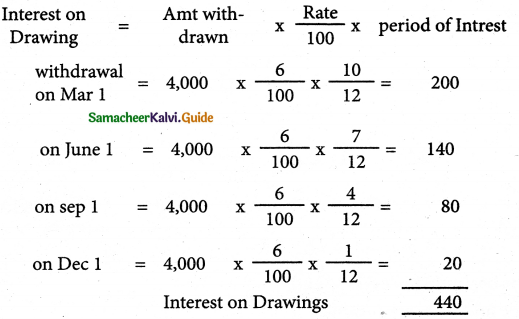
Question 14.
Mathew is a partner who withdrew ₹ 20,000 during the year 2018. Interest on drawings is charged at 10% per annum. Calculate interest on drawings on 31st December 2018.
Solution :

Note: Date of withdrawal is not given, interest is calculated for an average period of 6 months.
![]()
Question 15.
Santhosh is a partner in a partnership firm. As per the partnership deed, interest on drawings is charged at 6% per During the ended 31st December 2018 he withdrew as follows:
| Date |
Rs |
| Feb 1 | 2,000 |
| May 1 | 10,000 |
| July 1 | 4,000 |
| Oct 1 | 6,000 |
calculate the amount of interest on drawings by using the product method.
Solution :
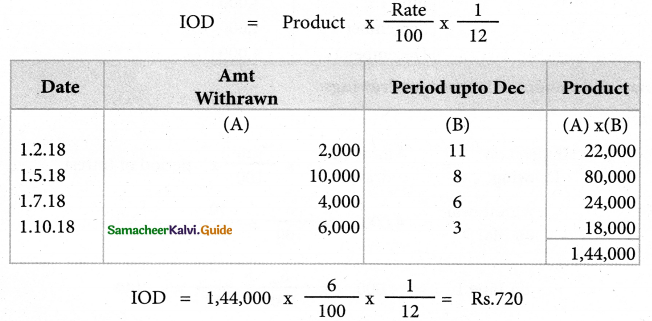
Question 16.
Kavitha is a partner in a firm. She withdraws ₹ 2,500 p.m. regularly interest on drawings is charged @ 4% p.a. Calculate the interest on drawings using average period, if she draws.
(i) at the beginning of every month
(ii) in the middle of every month
(iii) at the end of every month

Solution :
(i) at the beginning of every month
Amt withdrawn = 2,500 × 12 = Rs. 30,000
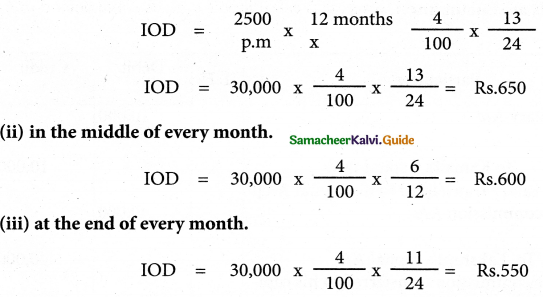
![]()
Question 17.
Kevin and Francis are partners. Kevin draws ₹ 5,000 at the end of each quarter. Interest on drawings is chargeable at 6% p.a. Calculate interest on drawings for the year ending 31st March 2019 using the average period.
Solution:
Kevin → Rs. 5,000 → at the end of each quarter
Average period = \(\frac{9+0}{2}=4 \frac{1}{2}\) Months
Amt withdrew = 5000 × 4 times = Rs. 20,000
IOD = 20,000 × \(\frac{6}{100} \times \frac{9}{24}\)= Rs. 450
Question 18.
Ram and Shyam were partners. Ram withdrew ₹ 18,000 at the beginning of each half year. Interest on drawings is chargeable @ 10% p.a. Calculate interest on the drawings for the year ending 31st December 2018 using the average period.
Solution :
Ram → Rs. 18,000 → beg of each half year.
Average period = \(\frac{12+6}{2}\) = 9 months
Amount withdrawn = 18,000 × 2 times = Rs. 36,000
IOD = 36,000 × \(\frac{10}{100} \times \frac{9}{12}\)= Rs. 2,700
Question 19.
Janani, Kamali, and Lakshmi are partners in the firm sharing profits and losses equally. As per the terms of the partnership deed, Kamali allows a monthly salary of ₹ 10,000, and Lakshmi is allowed a commission of ₹ 40,000 per annum for their contribution to the business of the firm. You are required to pass the necessary journal entry. Assume that their capitals are fluctuating.
Solution :
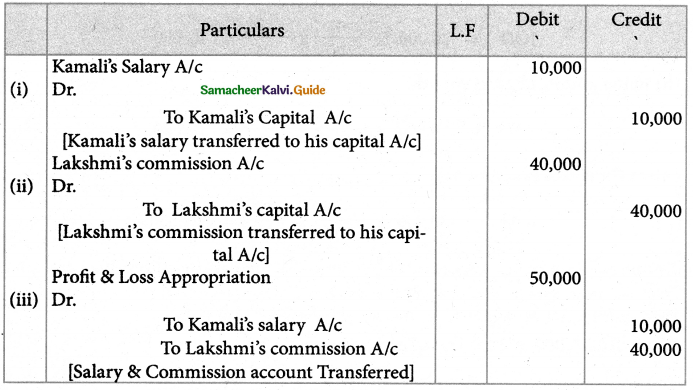
Question 20.
Sibi and Manoj are partners in a firm. Sibi is to get a commission of 20% of net profit before charging any commission. Manoj is to get a commission of 20% on net profit after charging all commission. Net profit for the year ended 31st Dec 2018 before ch y commission was ₹ 60,000. Find the commission of Sibi and Man Also show the distribution of profit.
Solution:
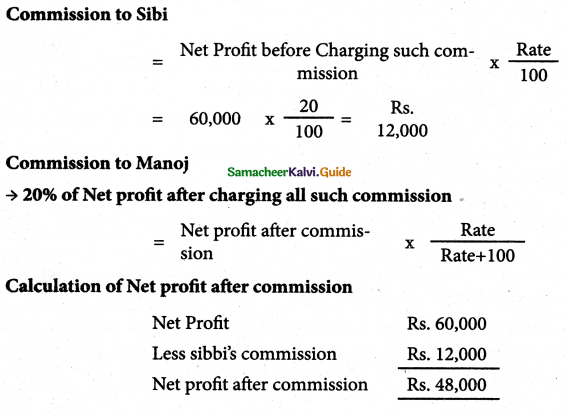
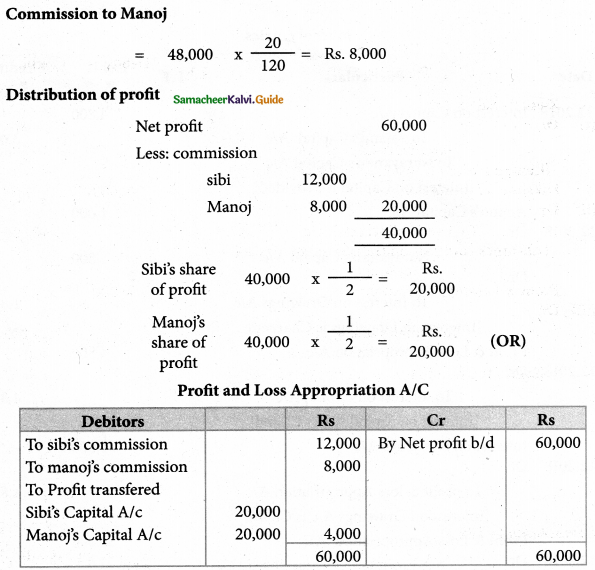
Note: Assumed to be equal partners (1:1)
![]()
Question 21.
Anand and Narayanan are partners in firm sharing profits and losses in the ratio of 5:3 On 1st January 2018, their capitals were ₹ 50,000 and ₹ 30,000 respectively. The partnership deed specifies the following:
(a) Interest on capital is to be allowed at 6% per annum.
(b) Interest on drawings charged to Anand and Narayanan are ₹ 1,000 and ₹ 800 respectively.
(c) The net profit of the firm before considering interest on capital and interest on drawings amounted to ₹ 35,000
Give necessary journal entries and prepare profit and loss appropriation account as on 31st December 2018. Assume that the capitals are fluctuating.
Solution :
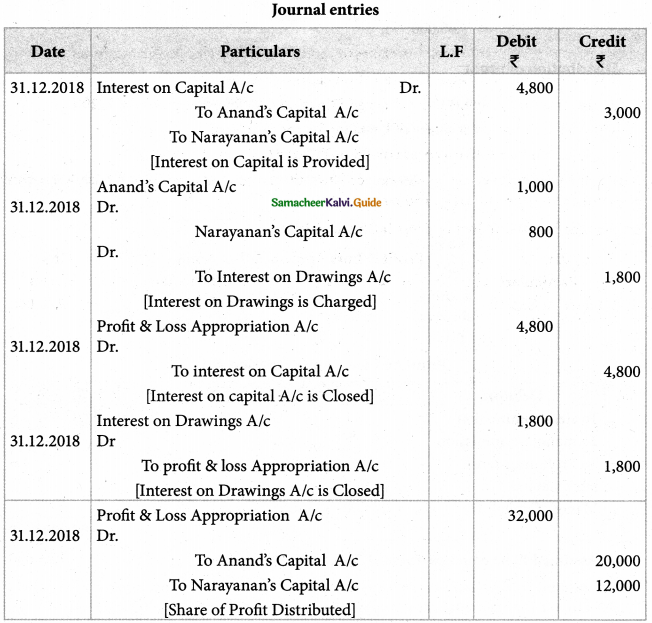
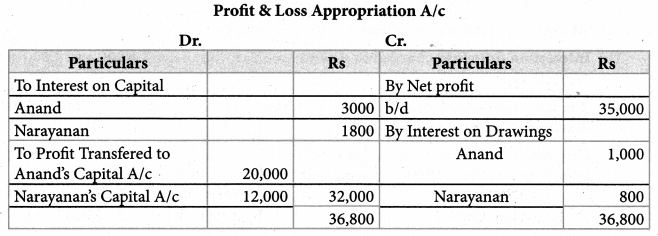
Question 22.
Dinesh and Sugumar entered into a partnership agreement on 1st January 2018, Dinesh contributing ₹ 1,50,000 and Sugumar ₹ 1,20,000 as capital. The agreement provided that:
(a) Profits and losses shared in the ratio 2:1 as between Dinesh and Sugumar.
(b) Partners to be entitled to interest on capital @ 4% p.a
(c) Interest on drawings to be charged Dinesh: ₹ 3,600 and Sugumar: ₹ 2,200
(d) Dinesh to receive a salary of ₹ 60,000 for the year, and
(e) Sugumar to receive a commission of ₹ 80,000
During the year ended on 31st December 2018, the firm made a profit of ₹ 2,20,000 before adjustment of interest, salary and commission.
Prepare the Profit and loss appropriation account.
Solution :
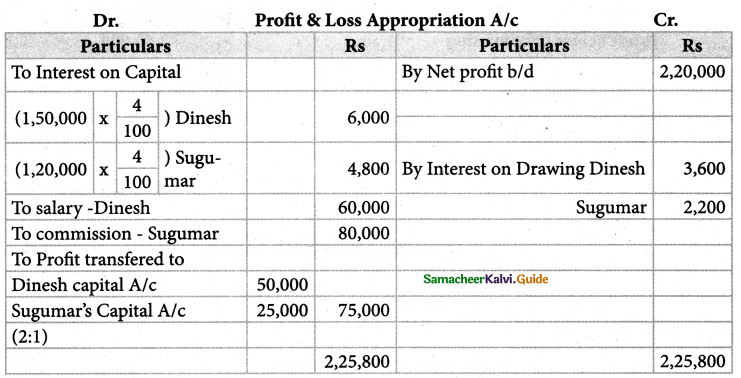
Question 23.
Antony and Ranjith Started a business on 1st April 2018 with capitals of ₹ 4,00,000 and ₹ 3,00,000 respect According to the Partnership Deed, Anton is to get the salary of ₹ 90,000 per annum, Ranj ith is got 25% commission on profit after allowing salary to Antony and interest on capital @ 5% p.a but before charging such commission. The profit-sharing ratio between the two partners is 1:1 During the year, the firm earned a profit of ₹ 3,65,000.
Prepare profit and loss appropriation account. The firm closes its accounts on 31st March every year.
Solution :

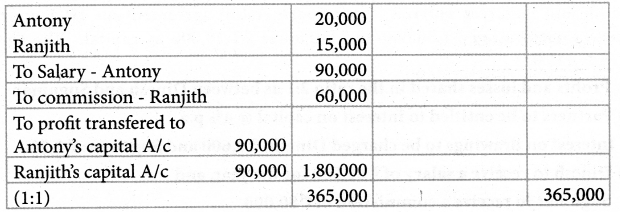
Calculation of profit before charging such commission
Net profit 3,65,000
Less: Ioc 20,000+15,000
salary 90,000 1,25,000
Profit before Commission 2,40,000
Commission = Net profit before commission × \(\frac{\text { Rate }}{100}\)
= 2,40,000 × \(\frac{25}{100}\)
= Rs.60,000
![]()
12th Accountancy Guide Accounts of Partnership Firms-Fundamentals Additional Important Questions and Answers
Question 1.
The minimum number of Reasons in a partnership firm is
(a) One
(b) Two
(c) Three
Answer:
(b) Two
Question 2.
In a partnership business, the agreement is
(a) Compulsory
(b) Optional
(c) Not necessary.
Answer:
(a) Compulsory
Question 3.
In a partnership, partners share their profits & losses in ‘ ratio
(a) their capital
(b) equal
(c) agreed
Answer:
(c) agreed
Question 4.
under fixed capital system, the profits and losses of partners will be transferred to their account
(a) Current
(b) Drawings
(c) Capital
Answer:
(a) Current
![]()
Question 5.
Interest on capital is calculated on the
(a) Opening capital
(b) Closing capital
(c) Average capital
Answer:
(a) Opening capital
Question 6.
Current accounts for partners will be opened under
(a) fixed capital method
(b) fluctuation capital method
(c) either fixed capital method or fluctuating capital method
Answer:
(a) fixed capital method
Question 7.
In the absence of agreement profits and losses are divided
(a) in the ratio of capitals
(b) in the ratio of time devoted by each partner
(c) equally
Answer:
(c) equally
![]()
Question 8.
x and y are partners sharing the profits and losses in the ratio of 2:3 with capitals of Rs. 1,20,000 and Rs. 60,000 respectively profits for the year are Rs. 9,000. If the partnership deed is silent as to interest on the capital show how profit is shared among x and y
(a) profit x – Rs.6,000 y – Rs.3,000
(b) profit x – Rs.3,600 y – Rs.5,400
(c) profit x – Rs.3,000 y – Rs. 6000
Hint:
Profit ₹ 9,000 Sharing ratio = 2:3
X Partner profit = 9,000 × 2/5 = ₹ 3,600
Y Partner profit = 9,000 × 3/5 = ₹ 5,400
Answer:
(b) profits – Rs.3,600 y – Rs.5,400
Question 9.
where a partner is entitled to interest on capital such interest will be payable
(a) Only out of profits
(b) Only out of Capital
(c) Out of profits or out of capital
Answer:
(a) Only out of profits
Question 10.
under fixed capital method, salary payable to a partner is recorded
(a) in the current account
(b) in capital account
(c) either in current account or capital account
Answer:
(a) in the current account
![]()
II Very Short Answer Questions
Question 11.
What is meant by the fluctuating capital method?
Answer:
Under this method, only a capital account is maintained for each partner. All the transactions between the partner and the firm are recorded in the capital account. This account is credited with the initial and additional capital introduced by the partner. The account is debited with capital withdrawn, drawings, interest on drawings, and share of loss of the partner. As a result, the balance in this account goes on fluctuating periodically. Under this method, the partner s capital account may show either credit balance or debit balance.
Question 12.
Mention the methods of calculating interest on drawings?
Answer:
- Direct Method
- Product Method
- Average period Method.
Question 13.
How to calculate the average period under different circumstances?
Answer:
The average period is computed as follows:
The following table shows the average period in months for withdrawal made at the beginning. In the middle and at the end of every month, quarter and half- year of the year.
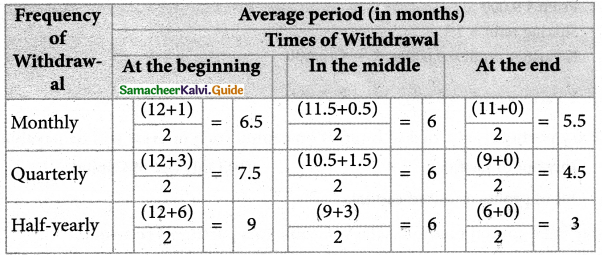
![]()
Additional problems:
Question 14.
Show how the following items will appear in the capital accounts of the partners, Anbu and Balu.
| Particulars | Anbu ₹ |
Balu |
| Capital on 1.4.2004 | 90,000 | 70,000 |
| Drawings during 2004 – 2005 | 12,000 | 9,000 |
| Interst on Drawings | 360 | 270 |
| Interest on capital | 5,400 | 4,200 |
| Partner’s salary | 12,000 | ……. |
| commission | — | 6000 |
| Share of profit for 2004-05 | 6,000 | 4000 |
Solution :
a) When capital accounts are fixed:
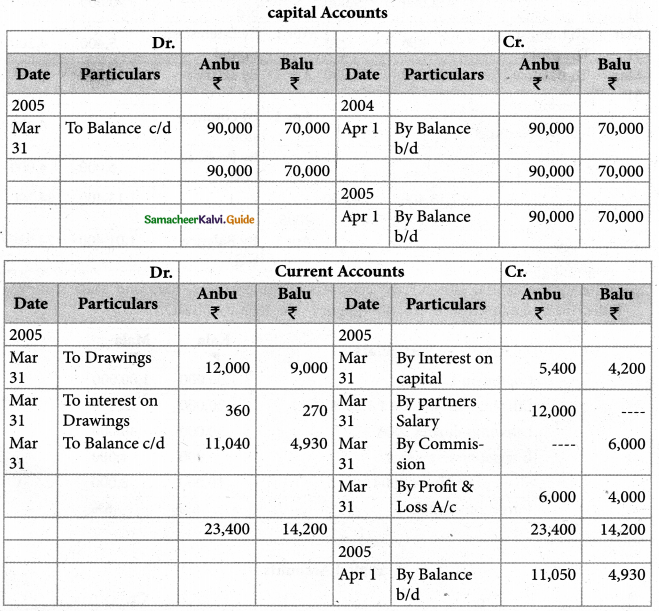
b) when capital accounts are fluctuating:
capital Accounts
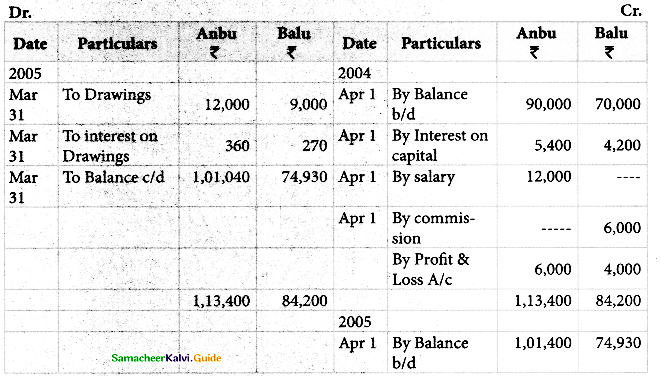
Question 15.
Write up the capital and. current accounts of the partners, Kala and Mala from the following and show how these will appear in the Balance Sheet.
| Particulars | Kala Rs. |
Mala Rs. |
| Capital on1.1.2004 | 1,50,000 | 1,00,000 |
| Current accounts on 1.1.2004(Cr.) | 20,000 | 15,000 |
| Drawings during 2004 | 30,000 | 40,000 |
| Interest on Drawings | 900 | 1,000 |
| Share of profit for 2004 | 10,000 | 8,000 |
| Interst on capital | 6% | 6% |
Solution :

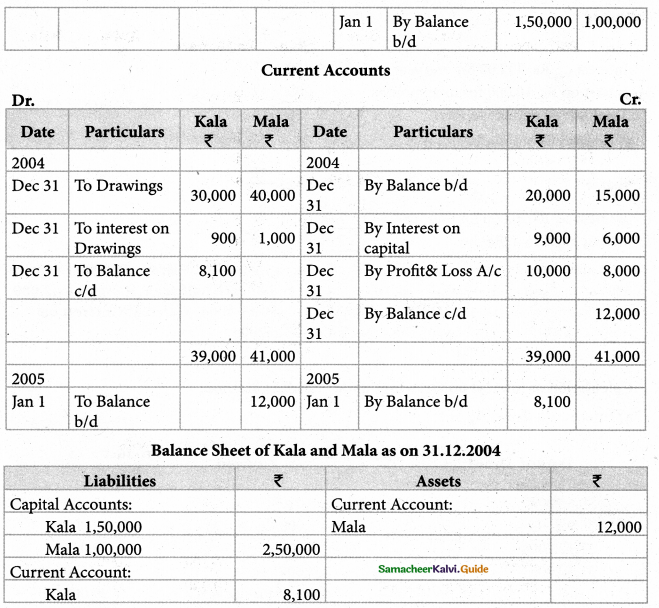
![]()
Question 16.
Ravi and Raghu started business on April 1, 2003, with a capital of 90,000 and Rs. 70,000 respectively. Ravi introduced Rs. 10,000 as additional capital on July 1, 2003. Interset on capital is to be allowed @ 10%. Calculate the interest payable to Ravi and Raghu for the year ending March 31, 2004.
Solution :

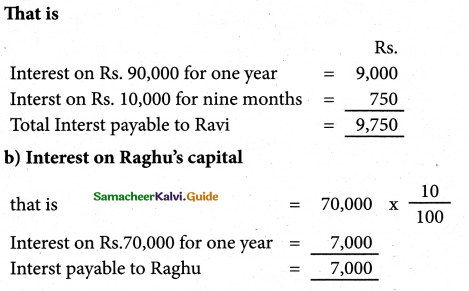
Question 17.
P, Q and R were partners sharing profits in the ratio of 3:2:1. P draws Rs.5,000 at the end of each quarter. Q draws Rs. 10,000 at the end of each half-year. R draws Rs.2,000 on 1.5.2004 Rs.3,000 on 31.10.2004, Rs.5,000 on 30.11.2004. Calculate interest on their drawings at 10% p.a for the year ending 31.3.2005.
Solution :
Calculation of interest on Drawings under Product Method:
a) Interest on drawing of P :

Interest on drawings at 10% p.a. on Rs.90,000
Interst on drawings = 90,000 × \(\frac{10}{100} \times \frac{1}{12}\) = Rs. 750
Interest on drawings of Q:
| Date of Drawings | Amount drawn Rs. |
Period | . Product Rs. |
| 30.9.2004 | 10,000 | 6 | 60,000 |
| 31.3.2005 | 10,000 | 0 | 0 |
| Sum of Products | 60,000 | ||
Interest on drawings at 10% p.a. on Rs.60,000
Interst on drawings = 60,000 × \(\frac{10}{100} \times \frac{1}{12}\) = Rs.500
Interst on drawings of R:

Interest on drawings at 10% p.a. on Rs.57,000
Interest on drawings = 57,000 x \(\frac{10}{100} \times \frac{1}{12}\) = Rs.475
![]()
Question 18.
Mahesh and Ramesh are partners sharing profits in the ratio of 3:2 with capitals of Rs.50,000 and Rs.40,000 respectively. Interest on capital is agreed at 8%p.a Interest on drawings is fixed at 10% p.a. The drawings of the partners were Rs.15,000 and Rs.10.000, the interest for Mahesh Rs.750 and for Ramesh Rs.500. Mahesh is entitled to a salary of Rs. 12,000 p.a. and Ramesh is entitled to get a commission of 10% on the Net Profit before charging such cc ion. The Net Profit of the firm before making the above adjustments was Rs.60,000 for the year ended 31st March 2005.
Prepare the profit and loss appropriation account.
Solution :
In the Books of the Firm Profit and Loss Appropriation Account

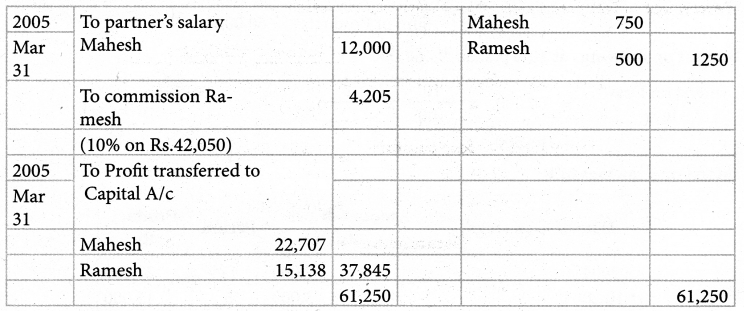
Note: Calculation of commission.
Step 1→ Total the credit side of the Profit and Loss Appropriation Account, i.e., Rs. 61,250
Step 2 → Total the debit side of the Profit and Loss Appropriation Account, i.e., Rs. 19,200
Step 3 → Find the balance, i.e., Rs. 42,050.
Step 4 → Apply the formula.
Commission = Net Profit before commission × \(\frac{\text { Rate of Commission }}{100} \text {\)
Commission = 42,050 × \(\frac{10}{100}\) = 4,205
The Balance of Rs. 37,845 (Rs.42,050 – Rs. 4,205) is transferred to Parnters Capital accounts in the ratio.
![]()
Question 19.
X and Y are partners in a firm, sharing profits losses equal. X is entitled to a salary of Rs. 5,000 p.m. Y is entitled to a con ion c 0% of Net Profit after charging such commission. Net Profit before charging commission and salary was Rs. 1,48,000. Show the Profit and loss appropriation account.
Solution:
a) Calculation of Salary to X:
5,0 p.m. for 12 months = 12 × 5,000 = Rs. 60,000
Calculation of Commission to Y:
Percentage of Net profit after charging the commission =
Net Profit before commission × \(\frac{\text { Rate of commission }}{100+\text { Rate of commision }}\)
Net Profit before commission = 1,48,000 – 60,000 = Rs.88,000
Commission = 88,000 × \(\frac{10}{100+10}\)
= 88,000 × \(\frac{10}{110}\)
= Rs.8,000
